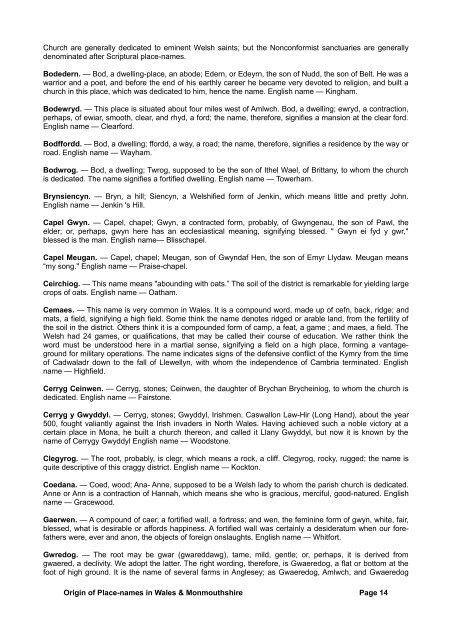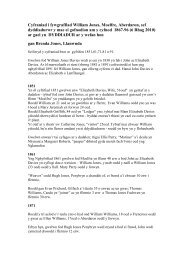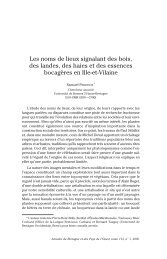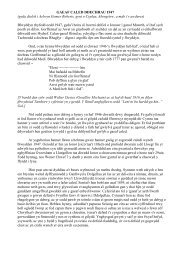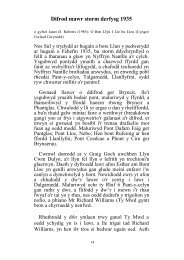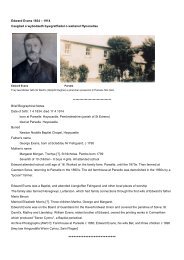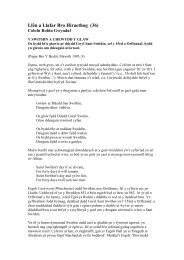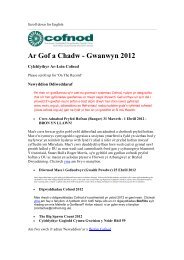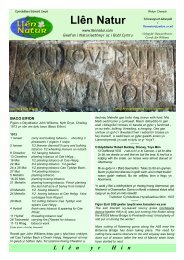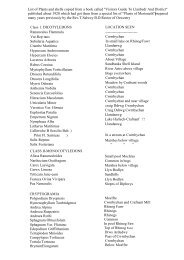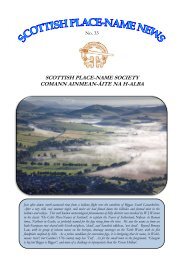Gwion, <strong>the</strong> son <strong>of</strong> Gwreang, <strong>the</strong> herald <strong>of</strong> Llanfair, <strong>the</strong> fane <strong>of</strong> <strong>the</strong> lady, <strong>in</strong> Caer E<strong>in</strong>iawn, <strong>the</strong> city <strong>of</strong> <strong>the</strong> just <strong>in</strong>Powys, <strong>the</strong> l<strong>and</strong> <strong>of</strong> rest. (Davies' Myth., p. dd?.)Dyfed, or Demetia. — This prov<strong>in</strong>ce embraced <strong>the</strong> counties <strong>of</strong> Pembroke, Carmar<strong>the</strong>n, <strong>and</strong> Cardigan; <strong>the</strong>former constituted <strong>the</strong> pr<strong>in</strong>cipal part, <strong>and</strong> is called Dyfed even to-day by <strong>the</strong> old <strong>in</strong>habitants. In <strong>the</strong> seventhcentury Dyfed consisted only <strong>of</strong> Pembrokeshire. Some derive <strong>the</strong> name from Dehtubarth, which is ra<strong>the</strong>r farfetched.Baxter derives it from defaid, sheep, <strong>and</strong> bases his belief on <strong>the</strong> fact that that part <strong>of</strong> <strong>the</strong> country <strong>in</strong>olden times was noted for its large number <strong>of</strong> sheep <strong>and</strong> goats. We are <strong>in</strong>duced to th<strong>in</strong>k <strong>the</strong> root is dwfn,deep or low, <strong>in</strong>dicat<strong>in</strong>g <strong>the</strong> geographical position <strong>of</strong> Dyfed, which is <strong>the</strong> lowest part <strong>of</strong> <strong>the</strong> Pr<strong>in</strong>cipality. Devonis probably <strong>of</strong> <strong>the</strong> same <strong>orig<strong>in</strong></strong>. Demetia is Dyfed Lat<strong>in</strong>ized.Gwent. — This territory comprised Glamorgan, Monmouth, Brecon, <strong>and</strong> Radnor counties. The word denotesan open or fair region, <strong>and</strong> was Lat<strong>in</strong>ized by <strong>the</strong> Romans <strong>in</strong>to Venta. Venta Silurum is now Caerwent, <strong>in</strong>Monmouthshire.ANGLESEY.Anglesey. — The Welsh name is Ynys Mon, <strong>the</strong> Isle <strong>of</strong> Mona. Mon is variously derived. Philotechnus derivesit from <strong>the</strong> Greek monos, alone, left alone, st<strong>and</strong><strong>in</strong>g alone, from its be<strong>in</strong>g separated by sea from <strong>the</strong> counties<strong>of</strong> North Wales. Dr. Owen Pughe seems to endorse <strong>the</strong> above : " Man, what is isolated, an isolated one, orthat is separate." The author <strong>of</strong> Mona Antique derives it from bdn, a stem, a base, a foundation, from itssituation at <strong>the</strong> extreme po<strong>in</strong>t <strong>of</strong> <strong>the</strong> Pr<strong>in</strong>cipality, or, perhaps, from its be<strong>in</strong>g called " Mdn, mam Cymru,"Mona, <strong>the</strong> mo<strong>the</strong>r <strong>of</strong> Wales. We are <strong>in</strong>duced to th<strong>in</strong>k that <strong>the</strong> Isle <strong>of</strong> Mona <strong>and</strong> <strong>the</strong> Isle <strong>of</strong> Man derive <strong>the</strong>ir<strong>names</strong> from mon, which means what is isolated, separate. The English name was bestowed upon it after <strong>the</strong>battle <strong>of</strong> Llanvaes, <strong>in</strong> which Egbert proved himself victor over Merddyn. In 818 or 819 <strong>the</strong> Saxon k<strong>in</strong>gsubdued Mona, <strong>and</strong> called it Anglesey, or <strong>the</strong> Isle <strong>of</strong> <strong>the</strong> Angles, or English. The term<strong>in</strong>al syllable, ey, is <strong>the</strong>Norse for isl<strong>and</strong>.Aberffraw. — This seaport village is situate at <strong>the</strong> mouth <strong>of</strong> <strong>the</strong> river Ffvaw. Aber, estuary; ffraw meansagitation, activity, swiftness. Effraw, awake, vigilant. The Romans called it Gadavia ; gada, to fall or rundown ; via, way, signify<strong>in</strong>g <strong>the</strong> swift or runn<strong>in</strong>g water. English name - Swiftmouth.Amlwch. — This name has elicited various conjectures. Some th<strong>in</strong>k it is a compound <strong>of</strong> aml-llwch, signify<strong>in</strong>ga dusty <strong>place</strong>. O<strong>the</strong>rs derive it thus: am, round, about; llwch, a lake, an <strong>in</strong>let <strong>of</strong> water, signify<strong>in</strong>g a circular<strong>in</strong>let <strong>of</strong> water. Llwch is cognate with <strong>the</strong> Scottish loch. Many <strong>place</strong>s <strong>in</strong> Wales take <strong>the</strong>ir <strong>names</strong> from this word,as Penllwch, Talyllychau, Llanlhvch, <strong>and</strong>, perhaps, Amlwch. In an ancient book, " The Record <strong>of</strong> Carnarvon,"supposed to be written about 1451, <strong>the</strong> name is spelt Amlogh, which <strong>in</strong>duces us to th<strong>in</strong>k <strong>the</strong> right word<strong>in</strong>g isAml-och, signify<strong>in</strong>g a <strong>place</strong> <strong>of</strong> many groans. Several <strong>names</strong> <strong>in</strong> <strong>the</strong> district po<strong>in</strong>t to <strong>the</strong> probability that bloodybattles were waged here <strong>in</strong> ancient times, such as Cadfa, battle<strong>place</strong> ; Cerryg-y-llefau, stones <strong>of</strong> weep<strong>in</strong>g;R.iyd y Galanastra, <strong>the</strong> ford <strong>of</strong> massacre ; <strong>and</strong> here Aml-och, <strong>the</strong> <strong>place</strong> <strong>of</strong> many groans. Groan<strong>in</strong>g <strong>and</strong>weep<strong>in</strong>g are universally <strong>the</strong> concomitants <strong>of</strong> bloodshed <strong>and</strong> war. English name- Groanston.Beaumaris. — Various <strong>names</strong> are given to this town - Bumaris, Bimaris, Beumarish, Bello-Mariseum, <strong>and</strong>Beaumaris. In <strong>the</strong> Myvyrian list <strong>of</strong> <strong>the</strong> parishes <strong>of</strong> Wales it is spelt Bywmares. Edmunds derives it from buw, acow; mor, <strong>the</strong> sea; <strong>and</strong> is, low; signify<strong>in</strong>g <strong>the</strong> low <strong>place</strong> <strong>of</strong> cows by <strong>the</strong> sea. Some th<strong>in</strong>k <strong>the</strong> name is acompounded form <strong>of</strong> bis, twice ; <strong>and</strong> maris, <strong>the</strong> sea, found<strong>in</strong>g <strong>the</strong>ir reason upon <strong>the</strong> position <strong>of</strong> <strong>the</strong> town asly<strong>in</strong>g between two seas, <strong>the</strong> Irish Sea <strong>and</strong> St. George's Channel. O<strong>the</strong>rs th<strong>in</strong>k <strong>the</strong> radices are beau,beautiful, f<strong>in</strong>e, <strong>and</strong> marie, sea ; signify<strong>in</strong>g a <strong>place</strong> near <strong>the</strong> beautiful sea. Many will have <strong>the</strong> suffix to bemarish, marsh, a tract <strong>of</strong> low l<strong>and</strong> occasionally covered with water, hence <strong>the</strong> name signifies <strong>the</strong> beautifulmarsh. The town was anciently called Forth Wygyr; porth, port; wygyr, perhaps a contraction <strong>of</strong> Gwaed-gwyr,men's blood; or it may be a corruption <strong>of</strong> Wig-ir; wig - gwig, an open<strong>in</strong>g <strong>in</strong> <strong>the</strong> wood, a wood; ir, fresh, florid.Pren ir, a green tree. The new name, Beaumaris, it is said, was given to <strong>the</strong> town by Edward I. He built <strong>the</strong>castle about <strong>the</strong> year 1285, <strong>and</strong> changed <strong>the</strong> name <strong>of</strong> <strong>the</strong> <strong>place</strong> to Beaumaris, descriptive <strong>of</strong> its pleasantsituation <strong>in</strong> low ground.Belan. — An abbreviation <strong>of</strong> Llanbeulan, <strong>the</strong> church dedicated to Beulan, son <strong>of</strong> Paul<strong>in</strong>us. English name-Beulan.Be<strong>the</strong>l. — So called after a Nonconformist chapel <strong>in</strong> <strong>the</strong> village. The sacred edifices <strong>of</strong> <strong>the</strong> EstablishedOrig<strong>in</strong> <strong>of</strong> Place-<strong>names</strong> <strong>in</strong> Wales & Monmouthshire Page 13
Church are generally dedicated to em<strong>in</strong>ent Welsh sa<strong>in</strong>ts; but <strong>the</strong> Nonconformist sanctuaries are generallydenom<strong>in</strong>ated after Scriptural <strong>place</strong>-<strong>names</strong>.Bodedern. — Bod, a dwell<strong>in</strong>g-<strong>place</strong>, an abode; Edern, or Edeyrn, <strong>the</strong> son <strong>of</strong> Nudd, <strong>the</strong> son <strong>of</strong> Belt. He was awarrior <strong>and</strong> a poet, <strong>and</strong> before <strong>the</strong> end <strong>of</strong> his earthly career he became very devoted to religion, <strong>and</strong> built achurch <strong>in</strong> this <strong>place</strong>, which was dedicated to him, hence <strong>the</strong> name. English name — K<strong>in</strong>gham.Bodewryd. — This <strong>place</strong> is situated about four miles west <strong>of</strong> Amlwch. Bod, a dwell<strong>in</strong>g; ewryd, a contraction,perhaps, <strong>of</strong> ewiar, smooth, clear, <strong>and</strong> rhyd, a ford; <strong>the</strong> name, <strong>the</strong>refore, signifies a mansion at <strong>the</strong> clear ford.English name — Clearford.Bodffordd. — Bod, a dwell<strong>in</strong>g; ffordd, a way, a road; <strong>the</strong> name, <strong>the</strong>refore, signifies a residence by <strong>the</strong> way orroad. English name — Wayham.Bodwrog. — Bod, a dwell<strong>in</strong>g; Twrog, supposed to be <strong>the</strong> son <strong>of</strong> I<strong>the</strong>l Wael, <strong>of</strong> Brittany, to whom <strong>the</strong> churchis dedicated. The name signifies a fortified dwell<strong>in</strong>g. English name — Towerham.Brynsiencyn. — Bryn, a hill; Siencyn, a Welshified form <strong>of</strong> Jenk<strong>in</strong>, which means little <strong>and</strong> pretty John.English name — Jenk<strong>in</strong> 's Hill.Capel Gwyn. — Capel, chapel; Gwyn, a contracted form, probably, <strong>of</strong> Gwyngenau, <strong>the</strong> son <strong>of</strong> Pawl, <strong>the</strong>elder; or, perhaps, gwyn here has an ecclesiastical mean<strong>in</strong>g, signify<strong>in</strong>g blessed. " Gwyn ei fyd y gwr,"blessed is <strong>the</strong> man. English name— Blisschapel.Capel Meugan. — Capel, chapel; Meugan, son <strong>of</strong> Gwyndaf Hen, <strong>the</strong> son <strong>of</strong> Emyr Llydaw. Meugan means“my song." English name — Praise-chapel.Ceirchiog. — This name means "abound<strong>in</strong>g with oats.” The soil <strong>of</strong> <strong>the</strong> district is remarkable for yield<strong>in</strong>g largecrops <strong>of</strong> oats. English name — Oatham.Cemaes. — This name is very common <strong>in</strong> Wales. It is a compound word, made up <strong>of</strong> cefn, back, ridge; <strong>and</strong>mats, a field, signify<strong>in</strong>g a high field. Some th<strong>in</strong>k <strong>the</strong> name denotes ridged or arable l<strong>and</strong>, from <strong>the</strong> fertility <strong>of</strong><strong>the</strong> soil <strong>in</strong> <strong>the</strong> district. O<strong>the</strong>rs th<strong>in</strong>k it is a compounded form <strong>of</strong> camp, a feat, a game ; <strong>and</strong> maes, a field. TheWelsh had 24 games, or qualifications, that may be called <strong>the</strong>ir course <strong>of</strong> education. We ra<strong>the</strong>r th<strong>in</strong>k <strong>the</strong>word must be understood here <strong>in</strong> a martial sense, signify<strong>in</strong>g a field on a high <strong>place</strong>, form<strong>in</strong>g a vantagegroundfor military operations. The name <strong>in</strong>dicates signs <strong>of</strong> <strong>the</strong> defensive conflict <strong>of</strong> <strong>the</strong> Kymry from <strong>the</strong> time<strong>of</strong> Cadwaladr down to <strong>the</strong> fall <strong>of</strong> Llewellyn, with whom <strong>the</strong> <strong>in</strong>dependence <strong>of</strong> Cambria term<strong>in</strong>ated. Englishname — Highfield.Cerryg Ce<strong>in</strong>wen. — Cerryg, stones; Ce<strong>in</strong>wen, <strong>the</strong> daughter <strong>of</strong> Brychan Bryche<strong>in</strong>iog, to whom <strong>the</strong> church isdedicated. English name — Fairstone.Cerryg y Gwyddyl. — Cerryg, stones; Gwyddyl, Irishmen. Caswallon Law-Hir (Long H<strong>and</strong>), about <strong>the</strong> year500, fought valiantly aga<strong>in</strong>st <strong>the</strong> Irish <strong>in</strong>vaders <strong>in</strong> North Wales. Hav<strong>in</strong>g achieved such a noble victory at acerta<strong>in</strong> <strong>place</strong> <strong>in</strong> Mona, he built a church <strong>the</strong>reon, <strong>and</strong> called it Llany Gwyddyl, but now it is known by <strong>the</strong>name <strong>of</strong> Cerrygy Gwyddyl English name — Woodstone.Clegyrog. — The root, probably, is clegr, which means a rock, a cliff. Clegyrog, rocky, rugged; <strong>the</strong> name isquite descriptive <strong>of</strong> this craggy district. English name — Kockton.Coedana. — Coed, wood; Ana- Anne, supposed to be a Welsh lady to whom <strong>the</strong> parish church is dedicated.Anne or Ann is a contraction <strong>of</strong> Hannah, which means she who is gracious, merciful, good-natured. Englishname — Gracewood.Gaerwen. — A compound <strong>of</strong> caer, a fortified wall, a fortress; <strong>and</strong> wen, <strong>the</strong> fem<strong>in</strong><strong>in</strong>e form <strong>of</strong> gwyn, white, fair,blessed, what is desirable or affords happ<strong>in</strong>ess. A fortified wall was certa<strong>in</strong>ly a desideratum when our forefa<strong>the</strong>rswere, ever <strong>and</strong> anon, <strong>the</strong> objects <strong>of</strong> foreign onslaughts. English name — Whitfort.Gwredog. — The root may be gwar (gwareddawg), tame, mild, gentle; or, perhaps, it is derived fromgwaered, a declivity. We adopt <strong>the</strong> latter. The right word<strong>in</strong>g, <strong>the</strong>refore, is Gwaeredog, a flat or bottom at <strong>the</strong>foot <strong>of</strong> high ground. It is <strong>the</strong> name <strong>of</strong> several farms <strong>in</strong> Anglesey; as Gwaeredog, Amlwch, <strong>and</strong> GwaeredogOrig<strong>in</strong> <strong>of</strong> Place-<strong>names</strong> <strong>in</strong> Wales & Monmouthshire Page 14
- Page 1 and 2: HANDBOOK OF THE ORIGIN OF PLACE-NAM
- Page 3 and 4: § § § § §The Author begs to st
- Page 5 and 6: pitiful cries of the railway offici
- Page 7 and 8: Bishop Percy says that "in England,
- Page 9 and 10: The city of Chester is still popula
- Page 11 and 12: There's Cumwhitton, Cumwhinton, Cum
- Page 13 and 14: Llwyn in its primary' sense means a
- Page 15: PLACE-NAMES IN WALES.Wales. — The
- Page 19 and 20: think he was a contemporary of St.
- Page 21 and 22: Rhosbeirio. — Rhos, a moor, a dry
- Page 23 and 24: of Brecknock," states that this vic
- Page 25 and 26: Cam cnwir ef Cwmdu,Cwm gwyn yw & n
- Page 27 and 28: Penderyn. — A corruption probably
- Page 29 and 30: Ardudwy. — Ar, upon or above; tud
- Page 31 and 32: to mark its pre-eminence over the o
- Page 33 and 34: Some think that eirw is a corruptio
- Page 35 and 36: present form — Caerfyrddin.Abergw
- Page 37 and 38: place of refuge; hence the name. En
- Page 39 and 40: Llansawyl. — The church was dedic
- Page 41 and 42: eject. The village took its name fr
- Page 43 and 44: house, and attempted to kill an inf
- Page 45 and 46: Gwydir. — Prima facie one may tak
- Page 47 and 48: Nefyn. — The church was probably
- Page 49 and 50: DENBIGHSHIRE.Anglicized form of Din
- Page 51 and 52: Llangollen. — From Collen, a sain
- Page 53 and 54: hands into their pockets to pay a c
- Page 55 and 56: Cefn. — The name signifies a ridg
- Page 57 and 58: Maesgarmon. — Named in honour of
- Page 59 and 60: Abertridwr. — Tridwr, three water
- Page 61 and 62: it is said, was originally built by
- Page 63 and 64: Cwmllynfell. — Cwm, a narrow vale
- Page 65 and 66: Gwarycaeau. — Gwdr, the nape of t
- Page 67 and 68:
means a cultivated region, a vale,
- Page 69 and 70:
Penrhiwfer.- Pen, head, top; rhiw,
- Page 71 and 72:
Port Talbot. — So called in 1835
- Page 73 and 74:
Trealaw. — This appellation was g
- Page 75 and 76:
Aberdyfi. — So called from its si
- Page 77 and 78:
Llanddwywe. — From Dwywau, a desc
- Page 79 and 80:
Crickhowell and some in the directi
- Page 81 and 82:
Griffithstown. — This village was
- Page 83 and 84:
and gwy, water. Treiddiod troth tna
- Page 85 and 86:
derive Tintern from din, fortified
- Page 87 and 88:
Caersws. — It appears that the Ro
- Page 89 and 90:
English name — Ervylton.Llanymech
- Page 91 and 92:
Angle. — Probably from the angle-
- Page 93 and 94:
Gellyswick. — Another hybrid. Gel
- Page 95 and 96:
that the two rivers in their flowin
- Page 97 and 98:
ecame the bishop of the see, and wa
- Page 99 and 100:
earth formerly stood on a summit on
- Page 101 and 102:
Pilleth. — A corruption of pwll,
- Page 103 and 104:
Howells, Rev. J., Mountain AshHowel
- Page 105 and 106:
Williams, D., PenywernWilliams, Rev


